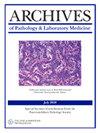Acquisition of Genetic Aberrations During the Progression of High-Grade Intraepithelial Lesions/Micro-Invasive Squamous Cancers to Widely Invasive Cervical Squamous Cell Cancer.
IF 3.2
3区 医学
Q2 MEDICAL LABORATORY TECHNOLOGY
引用次数: 1
Abstract
CONTEXT.— Acquisition of genetic aberrations during cervical carcinogenesis in individual patients is poorly documented. OBJECTIVE.— To provide a comparative analysis of high-grade squamous intraepithelial lesions (n = 7) and pT1a squamous cancers (n = 1) and their recurrences, subsequent widely invasive cancers, and metastases developed during 1-24 years. DESIGN.— Archival tissues of 8 patients were analyzed immunohistochemically for reserve-cell origin, human papillomavirus genotypes, mutations in 50 cancer genes, and chromosomal copy number variations. RESULTS.— Intraepithelial lesions arose either from cytokeratin 17- or 7-expressing reserve cells. All preinvasive and invasive tumors carried human papillomavirus high-risk genotypes and lacked somatic mutations. Chromosomal copy number variations were identified in all intraepithelial lesions and invasive cancers. Four of 8 high-grade intraepithelial lesions progressed to invasive cancer after incomplete treatment, and 4 of 8 invasive cancers arose de novo after in sano resection. Four of 8 cancers carried mutations with high mutational frequency (PIK3CA-E545K [n = 2]; PIK3CA and SMAD1 [n = 1]; HRAS, RB1, and EGFR [n = 1]), as did their corresponding regional metastases. One nonmetastasized cancer had a subclonal PIK3CA mutation, and an initially nonmutated, low-stage cancer developed ovarian metastases with PIK3CA amplification. One patient had neither mutations nor metastases. The patient with treated PIK3CA-E545K-mutated pT1a cancer developed a subsequent nonmutated intraepithelial lesion that progressed to invasive cancer with a subclonal PIK3CA-H1047R mutation. Cancer-related deaths in 4 of 8 (50%) patients occurred independent of mutational status or metastatic disease. CONCLUSIONS.— Recurrences arose after persistent or de novo human papillomavirus infection of residual reserve cells or squamous metaplasia. Activating driver mutations were identified in invasive cancers only. High mutational load correlated with metastases, which in turn represented clonal disease.高级别上皮内病变/微侵袭性鳞状癌向广泛侵袭性宫颈鳞状细胞癌进展过程中基因畸变的获取
上下文。-:个别患者在宫颈癌发生过程中获得遗传畸变的文献很少。-:对1-24年间发生的高级别鳞状上皮内病变(n = 7)和pT1a鳞状癌(n = 1)及其复发、随后的广泛浸润性癌症和转移进行比较分析。-:对8例患者的档案组织进行免疫组织化学分析,分析储备细胞来源、人乳头瘤病毒基因型、50个癌基因突变和染色体拷贝数变异。-:上皮内病变由表达细胞角蛋白17或7的储备细胞引起。所有侵袭前和侵袭性肿瘤均携带人乳头瘤病毒高危基因型,缺乏体细胞突变。在所有上皮内病变和浸润性癌症中都发现了染色体拷贝数变异。8例高级别上皮内病变中有4例在治疗不完全后进展为浸润性癌,8例浸润性癌中有4例在手术切除后重新发生。8例癌症中有4例携带高突变频率的突变(PIK3CA E545K [n = 2];PIK3CA和SMAD1 [n = 1];HRAS, RB1和EGFR [n = 1]),以及相应的区域转移。一种非转移性癌症具有PIK3CA亚克隆突变,一种最初未突变的低阶段癌症发展为PIK3CA扩增的卵巢转移。一名患者既没有突变也没有转移。接受PIK3CA e545k突变pT1a癌症治疗的患者随后发生非突变上皮内病变,并发展为具有亚克隆PIK3CA- h1047r突变的侵袭性癌症。8例患者中有4例(50%)的癌症相关死亡与突变状态或转移性疾病无关。-:复发发生在持续或新发的人乳头瘤病毒感染残余储备细胞或鳞状化生后。激活的驱动突变仅在侵袭性癌症中被发现。高突变负荷与转移相关,这反过来代表克隆性疾病。
本文章由计算机程序翻译,如有差异,请以英文原文为准。
求助全文
约1分钟内获得全文
求助全文
来源期刊
CiteScore
9.20
自引率
2.20%
发文量
369
审稿时长
3-8 weeks
期刊介绍:
Welcome to the website of the Archives of Pathology & Laboratory Medicine (APLM). This monthly, peer-reviewed journal of the College of American Pathologists offers global reach and highest measured readership among pathology journals.
Published since 1926, ARCHIVES was voted in 2009 the only pathology journal among the top 100 most influential journals of the past 100 years by the BioMedical and Life Sciences Division of the Special Libraries Association. Online access to the full-text and PDF files of APLM articles is free.

 求助内容:
求助内容: 应助结果提醒方式:
应助结果提醒方式:


